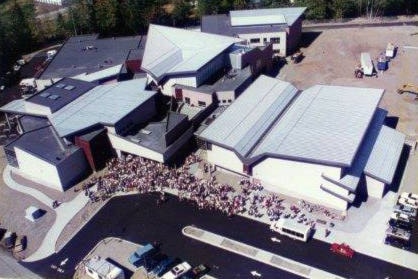Elida Peers | Contributed
“From camp huts to high-tech – 50 years” – This was the wording used in the souvenir booklet published by the EMCS 50th anniversary committee, when the new whale’s tail design school structure was opened in August 1996.
Driving by Edward Milne Community School today, one sees a great deal of road and landscape alteration and bustle of activities as the upcoming commercial development of the T’Sou-ke Nation moves forward, but the outline of the whale’s tail is a readily observed landmark.
The school reunion committee had sent invitations to hundreds of former students, and was thrilled at the response from all parts of North America and beyond, as past classmates and teachers converged at the school, looking for familiar faces and trying to catch up on everyone’s news.
Some posed in front of the new building as shown, while others were working alongside the old buildings (outside of photo, at right) preparing a salmon barbecue and Leechtown-style beef.
Larry Rumsby was in charge of the Leechtown beef, and his dedication led him to camp at the school overnight to oversee the sacks of beef, thoroughly soaked by the fire department and buried in a pit of coals, to be served in succulent perfection the next day.
During the Second World War, the site where the school stands was expropriated from the pioneer Milne farm and used as an army training camp.
When it was taken over by the newly formed School District No. 62 after the Cameron Commission’s report in 1946, school classes were initiated in the leftover army barracks buildings.
The first graduating class in 1947 had five students, Audrey (Sullivan) Wilson, Gwen (Jenner) Farmer, Joan (Rumsby) Zipp, Merle (Forrest) Proteau, and Laurie Wilson. Most of them were present for the lively celebration.
Del Clark, principal, and consultant Lori Messer led the building committee, while Phoebe Dunbar was co-ordinator of the community school’s programming. It was Phoebe’s whale skeleton project, of course, that provided the theme for the school’s architecture.
Diane Bernard, still active in the community today, was chair of the Sooke school board, and had this to say: “This state of the art facility will be at the leading edge of educational programs within the province and undoubtedly will be the most significant landmark in Sooke.”
•••
Elida Peers is the historian of the Sooke Region Museum.
